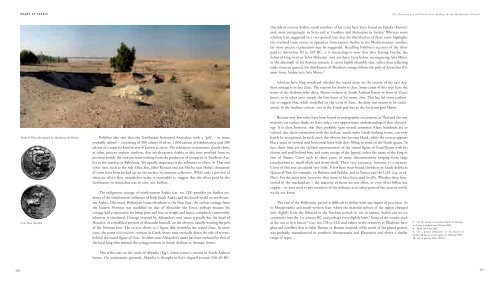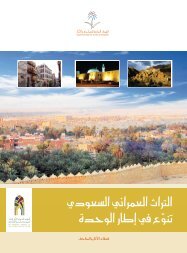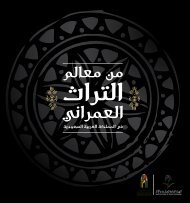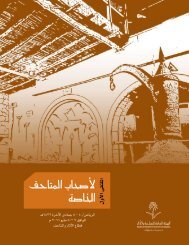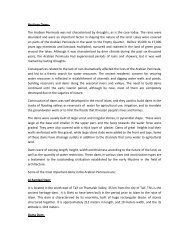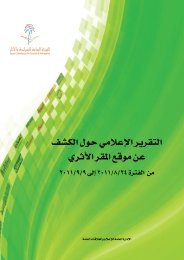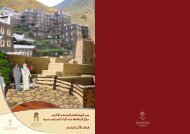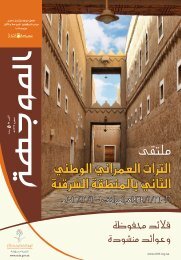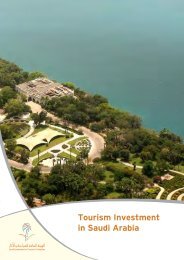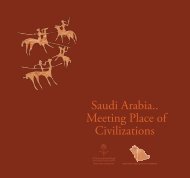Roads of Arabia
Roads of Arabia
Roads of Arabia
Create successful ePaper yourself
Turn your PDF publications into a flip-book with our unique Google optimized e-Paper software.
20 Arabie US_p372-385_BAT.qxd 23/06/10 22:02 Page 380<br />
ROADS OF ARABIA<br />
The Renaissance <strong>of</strong> North-East <strong>Arabia</strong> in the Hellenistic Period<br />
Outside <strong>of</strong> eastern <strong>Arabia</strong>, small numbers <strong>of</strong> his coins have been found on Failaka (Kuwait)<br />
and, most intriguingly, in Syria and at Gordion and Mektepini in Turkey. Whereas some<br />
scholars have suggested in a very general way that the distribution <strong>of</strong> these coins highlights<br />
the overland trade routes in operation from eastern <strong>Arabia</strong> to the Mediterranean, another,<br />
far more precise explanation may be suggested. Recalling Polybius’s account <strong>of</strong> the silver<br />
paid to Antiochus III in 205 BC, it is interesting to note that after leaving Gerrha, the<br />
Seleucid king went to Tylos (Bahrain) 7 and northern Syria before reconquering Asia Minor<br />
in the aftermath <strong>of</strong> his <strong>Arabia</strong>n sojourn. It seems highly plausible that, rather than reflecting<br />
trade routes in general, the distribution <strong>of</strong> Abyatha’s coinage follows the path <strong>of</strong> Antiochus III’s<br />
army from <strong>Arabia</strong> into Asia Minor. 8<br />
Scholars have long wondered whether the seated deity on the reverse <strong>of</strong> the east <strong>Arabia</strong>n<br />
coinage is in fact Zeus. The reasons for doubt is clear. Some coins <strong>of</strong> this type have the<br />
name <strong>of</strong> the <strong>Arabia</strong>n solar deity, Shams, written in South <strong>Arabia</strong>n letters in front <strong>of</strong> Zeus’s<br />
knees, or in other cases simply the first letter <strong>of</strong> his name, shin. This has led some authorities<br />
to suggest that, while modelled on the scene <strong>of</strong> Zeus, the deity was meant to be understood,<br />
in the <strong>Arabia</strong>n context, not as the Greek god but as the local sun god Shams.<br />
Tomb <strong>of</strong> Thaj, photograph by Humberto da Silveira<br />
Coin from Abyatha<br />
Polybius also says that the Gerrhaeans honoured Antiochus with a “gift” – or more<br />
probably tribute – consisting <strong>of</strong> 500 talents <strong>of</strong> silver, 1,000 talents <strong>of</strong> frankincense and 200<br />
talents <strong>of</strong> a superior kind <strong>of</strong> myrrh known as stacte. The references to aromatics clearly show,<br />
as other ancient authors confirm, that north-eastern <strong>Arabia</strong> at this time pr<strong>of</strong>ited from its<br />
position astride the caravan route leading from the producers <strong>of</strong> aromatics in Southern <strong>Arabia</strong><br />
to the markets in Babylonia. Yet equally important is the reference to silver. At Thaj and<br />
other sites, such as the Salt Mine Site, Jabal Kenzan and ash-Sha‘ba near H<strong>of</strong>uf, thousands<br />
<strong>of</strong> coins have been picked up on the surface by amateur collectors. While only a portion <strong>of</strong><br />
these are silver, they nonetheless make it reasonable to suggest that the silver paid by the<br />
Gerrhaeans to Antiochus was in coin, not bullion.<br />
The indigenous coinage <strong>of</strong> north-eastern <strong>Arabia</strong> (cat. no. 228) provides yet further evidence<br />
<strong>of</strong> the simultaneous influence <strong>of</strong> both South <strong>Arabia</strong> and the Greek world on north-eastern<br />
<strong>Arabia</strong>. Like many Hellenistic issues elsewhere in the Near East, the earliest coinage from<br />
the Eastern Province was modelled on that <strong>of</strong> Alexander the Great, perhaps because his<br />
coinage had a reputation for being pure and true to weight and hence completely trustworthy<br />
wherever it circulated. Coinage inspired by Alexander’s own issues typically has the head <strong>of</strong><br />
Heracles, or a modified portrait <strong>of</strong> Alexander himself, on the obverse, usually wearing the pelt<br />
<strong>of</strong> the Nemean lion. The reverse shows us a figure that resembles the seated Zeus. In some<br />
cases, the name ALEXANDROU written in Greek letters runs vertically down the side <strong>of</strong> reverse,<br />
behind the seated figure <strong>of</strong> Zeus. In other cases Alexander’s name has been replaced by that <strong>of</strong><br />
the local king who minted the coinage written in South <strong>Arabia</strong>n or Aramaic letters.<br />
Because very few coins have been found in stratigraphic excavations at Thaj and the vast<br />
majority are surface finds, we have only a very approximate understanding <strong>of</strong> their chronology.<br />
It is clear, however, that they probably span several centuries. Many hundreds are so<br />
stylized that their connection with the earliest, much more Greek-looking issues, can only<br />
barely be recognized. In such cases, the obverse has become blank, while the reverse appears<br />
like a maze <strong>of</strong> vertical and horizontal lines with dots filling in some <strong>of</strong> the blank spaces. In<br />
fact, these lines are the stylized representation <strong>of</strong> the seated figure <strong>of</strong> Zeus/Shams with his<br />
throne and staff behind him, and some vestige <strong>of</strong> the legend, either the name <strong>of</strong> the king or<br />
that <strong>of</strong> Shams. Coins such as these come in many denominations ranging from large<br />
tetradrachms to small obols and demi-obols. Their very existence, however, is a mystery.<br />
Coins <strong>of</strong> this sort circulated very little. A few have been found elsewhere in Saudi <strong>Arabia</strong> at<br />
Qaryat al-Faw, for example, on Bahrain and Failaka, and in Yemen and the UAE (e.g. at ed-<br />
Dur). For the most part, however, they seem to have been used locally. Whether they functioned<br />
in the marketplace – the majority <strong>of</strong> them are not silver, or even silver billon but<br />
copper – or were used to pay members <strong>of</strong> the military, as in other parts <strong>of</strong> the ancient world,<br />
we do not know.<br />
The end <strong>of</strong> the Hellenistic period is difficult to define with any degree <strong>of</strong> precision. As<br />
in Mesopotamia and south-western Iran, where the material culture <strong>of</strong> the region changed<br />
only slightly from the Seleucid to the Parthian period, so too in eastern <strong>Arabia</strong> can we see<br />
continuity into the 1st century BC and perhaps even slightly later. 9 Some <strong>of</strong> the tombs, such<br />
as the one at Ayn Jawan 10 (cat. nos 238 to 242) and others in the cemetery at Dhahran, have<br />
glass and jewellery that is either Roman or Roman-inspired, while much <strong>of</strong> the glazed pottery<br />
was probably manufactured in southern Mesopotamia and Khuzestan and shows a similar<br />
range <strong>of</strong> types.<br />
7. On the Greek inscriptions found in Bahrain,<br />
see Gatier, Lombard and Al-Sindi 2002.<br />
8. Huth and Potts 2002.<br />
9. On a general perspective on the history <strong>of</strong><br />
human habitation in the region, see Mouton 2009.<br />
10. See, in general, Potts 1993 b.<br />
This is the case on the issues <strong>of</strong> Abyatha (’byt‘), whose name is written in South <strong>Arabia</strong>n<br />
letters. On numismatic grounds, Abyatha is thought to have reigned around 230–20 BC.<br />
380<br />
381


